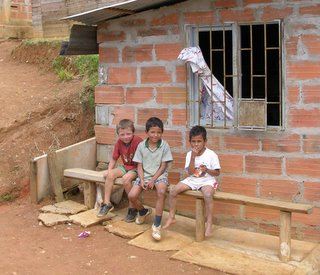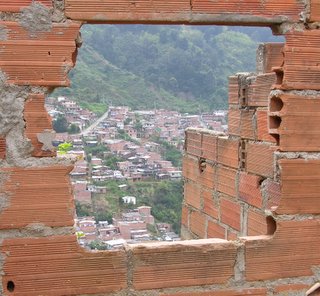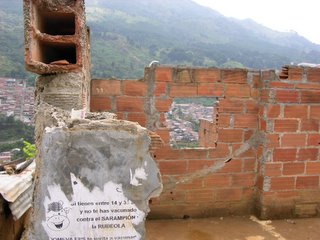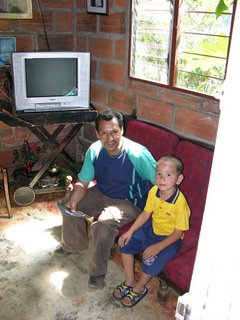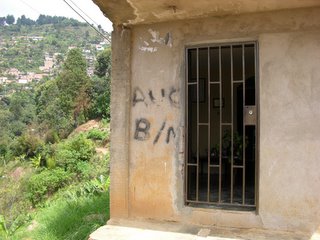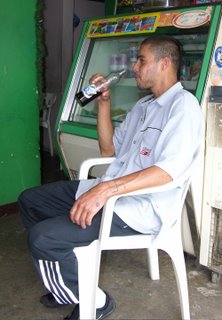Wednesday, December 21, 2005
Wednesday, December 14, 2005
Tuesday, December 13, 2005
The sixteen strategems for trafficking cocaine used by the Cali cartel:
1. Inside planks of mahogany. They looked at export statistics and discovered that one of Colombia's biggest exports was mahogany. Gilberto Rodriguez Orejuela went to the port of Buenaventura to study the trade. The timber goes in bundles of fifteen or twenty planks, and a plank is about 3 inches thick. They would place the "merchandise" in three holes along the plank, then seal it shut with powerful glue. The cocaine was flown to a secret airfield in Honduras, where the "carpentry" was done, then the wood was sent to Miami and New York. "There were approximately six such shipments of different quantities, and in the this way I managed to export 1,600 kilos."
2. Inside posts of cement. In 1990 and 1991 they sent cocaine via Venezuela in this way. There were three dispatches, each containing 200 or 300 kilos. In August 1991 US authorities intercepted a shipment.
3. In small bags of coffee. On three occasions in 1992 and 1993 they sent cocaine by sea from the port of Buenaventura in Colombia to Miami via Panama. The "owner of the route" was a Cuban-American called Jorge Lopez who constantly sent coffee this way, without drugs. "In each voyage I sent 300 or 400 kilos for a total of 800 or 900 kilos... the last shipment was intercepted by US authorities in August of 1993."
4. In door frames from Honduras. On about six occasions from 1984 cocaine was sent in this way to a company in Miami. A total of 650 kilos reached the US in this way.
5. In containers of broccoli and melon.From 1987 they sent cocaine from Colombia to Guatemala using secret airfields, then to Miami in refrigerated containers containing melon and broccoli. "We did fifteen or sixteen trips in which I sent 100 or 200 kilos for a total of about 1,200 kilos... the last two trips in 1992 were intercepted by US authorities."
6. In boxes of tiles. In April 1992 the brothers sent cocaine to Miami, via Panama, hidden in boxes of tiles to a company called Celeste Internacional. "The owner of Celeste Internacional was completely innocent, or blind, as they say, and was unaware what was going on behind his back."
7. In containers of insecticide belong to Dupont. They made two shipments between 1982 and 1984 from the port of Barranquilla, on Colombia's Caribbean coast, hidden in a shipment of extremely toxic insecticide. They sent 100 kilos each time, the second of which was intercepted. "Afterwards the owner of the route told me that not only had the merchandise been lost, but that they had started legal proceedings in the US, and detained several people.
8. Disguised as coal. In 1992 or 1993 they sent two shipments to "the Republic of Holland", 500 kilos each time. They mixed rocks of fake coal, containing cocaine, in with a shipment of real coal. "I don't know what the material was, but it looked identical to natural coal," said Gilberto.
9. "Cocaine that rains from heaven." From January 1993 until April or May of the same year, cocaine was dropped into the Caribbean, then picked up by a boat and taken to Florida. The shipment was 500 kilos, of which 200 kilos belonged to Gilberto Rodriguez Orejuela. This shipment was intercepted by authorities in Miami, who had informers infiltrated in the gang.
10. Inside a machine for making toilet paper. The machine was called "Yankee Dryer". The machine was sent to Venezuela, then by sea to a company in New York. "The merchandise was hidden in a double bottom in the drying cylinder, a steel cylinder 3.5m in diameter. The machine went to New York on the pretext of repairing it, with the aim of re-exporting it to Colombia. I sent 250 kilos."
11. In drums of castor oil. On four or five occasions they sent 50-kilo shipments of cocaine to the United States and "the republic of Canada", inside drums of castor oil. The drums had a double wall, and cocaine was hidden in the cavity. Canadian authorities intercepted the final shipment, and made several arrests.
12. In coffee grinding machines. Between 1992 and 1994, 200 kilos of cocaine was sent to Guatemala hidden in the machines, then to Houston.
13. In frozen lobsters. "In 1995 I sent 100 kilos to Ecuador to be re-exported to Miami in containers of lobsters.... in December of 1994 I collaborated with a "Mr Ricky" to send cocaine from Cartagena to Mexico, then on to Houston.... Using this method I managed to smuggle about 150 kilos, and the rest was lost.
14. In containers of vegetables. Towards the end of 1987 they sent cocaine in light aircraft to Guatemala, then to the United States hidden in containers of vegetables. Each shipment contained about 300 kilos.
15. In ceramics. 500 kilos of cocaine was sent to Panama, with the idea sending it to Miami hidden inside ceramics. But the cocaine was captured in Panama City.
16. From Mexico in various ways. Between December 1993 and the first months of 1994, about 14 tonnes of cocaine was sent to some Mexican traffickers who sent it on to Houston or Los Angeles. "But due to secrecy and prudence we aren't sure what method they used."
From The Secret Confessions by the Rodriguez Orejuela brothers. The book is a series of interviews with Colombian prosecutors.
1. Inside planks of mahogany. They looked at export statistics and discovered that one of Colombia's biggest exports was mahogany. Gilberto Rodriguez Orejuela went to the port of Buenaventura to study the trade. The timber goes in bundles of fifteen or twenty planks, and a plank is about 3 inches thick. They would place the "merchandise" in three holes along the plank, then seal it shut with powerful glue. The cocaine was flown to a secret airfield in Honduras, where the "carpentry" was done, then the wood was sent to Miami and New York. "There were approximately six such shipments of different quantities, and in the this way I managed to export 1,600 kilos."
2. Inside posts of cement. In 1990 and 1991 they sent cocaine via Venezuela in this way. There were three dispatches, each containing 200 or 300 kilos. In August 1991 US authorities intercepted a shipment.
3. In small bags of coffee. On three occasions in 1992 and 1993 they sent cocaine by sea from the port of Buenaventura in Colombia to Miami via Panama. The "owner of the route" was a Cuban-American called Jorge Lopez who constantly sent coffee this way, without drugs. "In each voyage I sent 300 or 400 kilos for a total of 800 or 900 kilos... the last shipment was intercepted by US authorities in August of 1993."
4. In door frames from Honduras. On about six occasions from 1984 cocaine was sent in this way to a company in Miami. A total of 650 kilos reached the US in this way.
5. In containers of broccoli and melon.From 1987 they sent cocaine from Colombia to Guatemala using secret airfields, then to Miami in refrigerated containers containing melon and broccoli. "We did fifteen or sixteen trips in which I sent 100 or 200 kilos for a total of about 1,200 kilos... the last two trips in 1992 were intercepted by US authorities."
6. In boxes of tiles. In April 1992 the brothers sent cocaine to Miami, via Panama, hidden in boxes of tiles to a company called Celeste Internacional. "The owner of Celeste Internacional was completely innocent, or blind, as they say, and was unaware what was going on behind his back."
7. In containers of insecticide belong to Dupont. They made two shipments between 1982 and 1984 from the port of Barranquilla, on Colombia's Caribbean coast, hidden in a shipment of extremely toxic insecticide. They sent 100 kilos each time, the second of which was intercepted. "Afterwards the owner of the route told me that not only had the merchandise been lost, but that they had started legal proceedings in the US, and detained several people.
8. Disguised as coal. In 1992 or 1993 they sent two shipments to "the Republic of Holland", 500 kilos each time. They mixed rocks of fake coal, containing cocaine, in with a shipment of real coal. "I don't know what the material was, but it looked identical to natural coal," said Gilberto.
9. "Cocaine that rains from heaven." From January 1993 until April or May of the same year, cocaine was dropped into the Caribbean, then picked up by a boat and taken to Florida. The shipment was 500 kilos, of which 200 kilos belonged to Gilberto Rodriguez Orejuela. This shipment was intercepted by authorities in Miami, who had informers infiltrated in the gang.
10. Inside a machine for making toilet paper. The machine was called "Yankee Dryer". The machine was sent to Venezuela, then by sea to a company in New York. "The merchandise was hidden in a double bottom in the drying cylinder, a steel cylinder 3.5m in diameter. The machine went to New York on the pretext of repairing it, with the aim of re-exporting it to Colombia. I sent 250 kilos."
11. In drums of castor oil. On four or five occasions they sent 50-kilo shipments of cocaine to the United States and "the republic of Canada", inside drums of castor oil. The drums had a double wall, and cocaine was hidden in the cavity. Canadian authorities intercepted the final shipment, and made several arrests.
12. In coffee grinding machines. Between 1992 and 1994, 200 kilos of cocaine was sent to Guatemala hidden in the machines, then to Houston.
13. In frozen lobsters. "In 1995 I sent 100 kilos to Ecuador to be re-exported to Miami in containers of lobsters.... in December of 1994 I collaborated with a "Mr Ricky" to send cocaine from Cartagena to Mexico, then on to Houston.... Using this method I managed to smuggle about 150 kilos, and the rest was lost.
14. In containers of vegetables. Towards the end of 1987 they sent cocaine in light aircraft to Guatemala, then to the United States hidden in containers of vegetables. Each shipment contained about 300 kilos.
15. In ceramics. 500 kilos of cocaine was sent to Panama, with the idea sending it to Miami hidden inside ceramics. But the cocaine was captured in Panama City.
16. From Mexico in various ways. Between December 1993 and the first months of 1994, about 14 tonnes of cocaine was sent to some Mexican traffickers who sent it on to Houston or Los Angeles. "But due to secrecy and prudence we aren't sure what method they used."
From The Secret Confessions by the Rodriguez Orejuela brothers. The book is a series of interviews with Colombian prosecutors.

Dora Luz Guerra (19) joined the guerrillas when she was twelve, and spent seven years with the 9th Front of the FARC. She left because of "bad treatment". Shemet Milciades Pertus (23) two months ago in a hostel for demobilized fighters, and last month they got married. Milciades was in the AUC's Bloque Centauros.
They are living together in Medellin.
Monday, December 12, 2005
From November, an interview with Dr Theodore Dalrymple about the Paris riots (for El Espectador)
-You’ve visited French slums, and you’ve also seen Latin American slums. Are they basically the same kind of thing?
No, not at all the same kind of thing. Quite obviously the physical conditions are very different, and also I think the moral conditions are different, the psychological conditions are very different. The French slums, as you call them, aren’t really slums in the sense that they’re terrible. They’re not very beautiful but they’re physically adequate for life.That isn’t the problem, really.
-What is the problem? What do think is cau sing this violence?
The people are completely dependent, there is no economic activity in these towns apart from drug trafficking, really, and other forms of trafficking. There’s not much hope that things are going to change for them. Up to 40% of people under the age of 25 are unemployed, most of them are probably never going to get employed, if they do get employed they’ll be employed not earning very much more than they get for doing nothing, so they feel very aggrieved, and I think that’s a large part of the problem. The situation that’s going on now is fundamentally not very different from what’s been going on for a long time. It’s true that the riots are much worse than anything before, but there’s actually been quite along history of these riots, precipitated by events very similar to the ones that are going on now, though not on such a large scale, obviously.
-Do you think this is something like the Brixton riots or the LA riots that will flare up and disappear, or do you think it’s the start of something new?
In some ways it’s worse, more serious. I was thinking about this, I was thinking about the difference between the situation of Muslims in Britain and these mainly Muslim people in France. I lived in Birmingham where there were a large number of Muslims, and they lived in Victorian terraced houses, a more social form of housing, but also there were substantial numbers of people there who had businesses, and in those areas you would see whole rows of shops and in particular restaurants, which meant that of course there was a group of people in those areas who the last thing they would want, would be a rampaging mob coming through the streets smashing their businesses. There were whole areas devoted to restaurants, and ordinary white people would go there so that there was at least some connection between the communities, they were not completely alien to one other. The fact is that I imagine most Parisians would have no reason to go to the places where these riots are taking place, would never actually have been to them.
-What percentage of the people in these areas are from north Africa?
I would imagine it’s something like 60%, and 30% would be black Africans, there’s a very small number of whites. There’s a very much higher percentage of young people, double the national average.
-You said the time you went there you felt physically threatened.
Yes. I think almost everyone who goes there tends to feel that menace, and also the great hostility towards you which is greater than I’ve experienced almost anywhere. I’ve been to South Africa’s. I didn’t feel any menace at all in Guatemala.
-You never felt threatened in the same way in South America?
I don’t remember ever feeling that. In Colombia one felt in danger because of the kidnapping, but I didn’t feel hostility from ordinary people. The last time Iwas in Bogota, when the concierge tells you not to take any old taxi, you have to order it in advance so that you’re not kidnapped, that does lead you to be nervous, although I can’t remember feeling any hostility of any Colombians to us… If you went to cites around Paris I don’t think it would take youvery long to pick up the notion that you weren’t welcome there, and so in that sense it’s worse, it’s far worse.
-Under what circumstances should European countries accept immigrants?
My view is that one of the problems in France is the very rigid labour laws, which protect people who are already in jobs, but make it very difficult for people without jobs to get jobs. I think it’s a difficult problem. I’ve often thought about the question of people who are illegal, and I’m fairly relaxed about that provided those people find work, and if they findwork and don’t commit any offences, I don’t really mind them coming. But that of course means that you have to have an open economy.
-Do you think there’s any prospect of that in places like France and Germany?
I think there’s possibly more chance in Germany. In France they have to try and square the circle. When the French government attempts to reform there are huge protests from people who are more powerful than these rioters. In a sense the choice is between offending their core population or having riots which from time to time they will have to repress. I don’t think there’s much hope of openness of the French economy because the French population is actually against such openness, as far as understand it. That’s a fundamental contradiction which the government willhave to try and resolve and I don’t think that it’s got much will to do it. It would have to be very brave to do it.
-Why do you this is happening specifically in France? Do you think it could also break out in places like Holland and Belgium and Britain?
I think no country can afford to be complacent. Mitterrand said, during the Los Angeles riots, that we’ll never have riots like that in France because we have so much social security, where in my view it is social security that causes the riots, is the ultimate cause of the riots, not the solution to the riots. SoI don’t think one can be complacent. I don’t know enough about the way that people are living in Belgium and Holland, I don’t know whether the same situation exists in Belgium and Holland with regard to the concentration of these people in areas, and where theyare both geographically separate and economically separate. I don’t think it’s as bad in England, but of course you can’t be complacent in England after the bombings of the seventh of July, so far as I understand it Britain is becoming slightly more segregated along French lines rather than less. I went to Bradford and it is quite segregated. The difference is that until fairly recently Britain had a much more open economy than France. And so people were able to start businesses, which I think is absolutely crucial here, but of course in Britain Mr Brown is doing everything possible to go in the French direction, which I think will be a disaster both economically and socially.
-How many times have you been to Colombia?
Three or four times. I like the country very much, I think it’s a wonderful place.
-You’ve visited French slums, and you’ve also seen Latin American slums. Are they basically the same kind of thing?
No, not at all the same kind of thing. Quite obviously the physical conditions are very different, and also I think the moral conditions are different, the psychological conditions are very different. The French slums, as you call them, aren’t really slums in the sense that they’re terrible. They’re not very beautiful but they’re physically adequate for life.That isn’t the problem, really.
-What is the problem? What do think is cau sing this violence?
The people are completely dependent, there is no economic activity in these towns apart from drug trafficking, really, and other forms of trafficking. There’s not much hope that things are going to change for them. Up to 40% of people under the age of 25 are unemployed, most of them are probably never going to get employed, if they do get employed they’ll be employed not earning very much more than they get for doing nothing, so they feel very aggrieved, and I think that’s a large part of the problem. The situation that’s going on now is fundamentally not very different from what’s been going on for a long time. It’s true that the riots are much worse than anything before, but there’s actually been quite along history of these riots, precipitated by events very similar to the ones that are going on now, though not on such a large scale, obviously.
-Do you think this is something like the Brixton riots or the LA riots that will flare up and disappear, or do you think it’s the start of something new?
In some ways it’s worse, more serious. I was thinking about this, I was thinking about the difference between the situation of Muslims in Britain and these mainly Muslim people in France. I lived in Birmingham where there were a large number of Muslims, and they lived in Victorian terraced houses, a more social form of housing, but also there were substantial numbers of people there who had businesses, and in those areas you would see whole rows of shops and in particular restaurants, which meant that of course there was a group of people in those areas who the last thing they would want, would be a rampaging mob coming through the streets smashing their businesses. There were whole areas devoted to restaurants, and ordinary white people would go there so that there was at least some connection between the communities, they were not completely alien to one other. The fact is that I imagine most Parisians would have no reason to go to the places where these riots are taking place, would never actually have been to them.
-What percentage of the people in these areas are from north Africa?
I would imagine it’s something like 60%, and 30% would be black Africans, there’s a very small number of whites. There’s a very much higher percentage of young people, double the national average.
-You said the time you went there you felt physically threatened.
Yes. I think almost everyone who goes there tends to feel that menace, and also the great hostility towards you which is greater than I’ve experienced almost anywhere. I’ve been to South Africa’s. I didn’t feel any menace at all in Guatemala.
-You never felt threatened in the same way in South America?
I don’t remember ever feeling that. In Colombia one felt in danger because of the kidnapping, but I didn’t feel hostility from ordinary people. The last time Iwas in Bogota, when the concierge tells you not to take any old taxi, you have to order it in advance so that you’re not kidnapped, that does lead you to be nervous, although I can’t remember feeling any hostility of any Colombians to us… If you went to cites around Paris I don’t think it would take youvery long to pick up the notion that you weren’t welcome there, and so in that sense it’s worse, it’s far worse.
-Under what circumstances should European countries accept immigrants?
My view is that one of the problems in France is the very rigid labour laws, which protect people who are already in jobs, but make it very difficult for people without jobs to get jobs. I think it’s a difficult problem. I’ve often thought about the question of people who are illegal, and I’m fairly relaxed about that provided those people find work, and if they findwork and don’t commit any offences, I don’t really mind them coming. But that of course means that you have to have an open economy.
-Do you think there’s any prospect of that in places like France and Germany?
I think there’s possibly more chance in Germany. In France they have to try and square the circle. When the French government attempts to reform there are huge protests from people who are more powerful than these rioters. In a sense the choice is between offending their core population or having riots which from time to time they will have to repress. I don’t think there’s much hope of openness of the French economy because the French population is actually against such openness, as far as understand it. That’s a fundamental contradiction which the government willhave to try and resolve and I don’t think that it’s got much will to do it. It would have to be very brave to do it.
-Why do you this is happening specifically in France? Do you think it could also break out in places like Holland and Belgium and Britain?
I think no country can afford to be complacent. Mitterrand said, during the Los Angeles riots, that we’ll never have riots like that in France because we have so much social security, where in my view it is social security that causes the riots, is the ultimate cause of the riots, not the solution to the riots. SoI don’t think one can be complacent. I don’t know enough about the way that people are living in Belgium and Holland, I don’t know whether the same situation exists in Belgium and Holland with regard to the concentration of these people in areas, and where theyare both geographically separate and economically separate. I don’t think it’s as bad in England, but of course you can’t be complacent in England after the bombings of the seventh of July, so far as I understand it Britain is becoming slightly more segregated along French lines rather than less. I went to Bradford and it is quite segregated. The difference is that until fairly recently Britain had a much more open economy than France. And so people were able to start businesses, which I think is absolutely crucial here, but of course in Britain Mr Brown is doing everything possible to go in the French direction, which I think will be a disaster both economically and socially.
-How many times have you been to Colombia?
Three or four times. I like the country very much, I think it’s a wonderful place.



